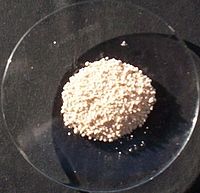Hafnium(IV) oxide
 |
|
 |
|
| Names | |
|---|---|
|
IUPAC name
Hafnium(IV) oxide
|
|
| Other names
Hafnium dioxide
Hafnia |
|
| Identifiers | |
|
3D model (Jmol)
|
|
| ChemSpider | |
| ECHA InfoCard | 100.031.818 |
|
PubChem CID
|
|
|
|
|
|
| Properties | |
| HfO2 | |
| Molar mass | 210.49 g/mol |
| Appearance | off-white powder |
| Density | 9.68 g/cm3, solid |
| Melting point | 2,758 °C (4,996 °F; 3,031 K) |
| Boiling point | 5,400 °C (9,750 °F; 5,670 K) |
| insoluble | |
| −23.0·10−6 cm3/mol | |
| Hazards | |
| Flash point | Non-flammable |
| Related compounds | |
|
Other cations
|
Titanium(IV) oxide Zirconium(IV) oxide |
|
Related compounds
|
Hafnium nitride |
|
Except where otherwise noted, data are given for materials in their standard state (at 25 °C [77 °F], 100 kPa).
|
|
|
|
|
| Infobox references | |
Hafnium(IV) oxide is the inorganic compound with the formula HfO2. Also known as hafnia, this colourless solid is one of the most common and stable compounds of hafnium. It is an electrical insulator with a band gap of 5.3~5.7 eV. Hafnium dioxide is an intermediate in some processes that give hafnium metal.
Hafnium(IV) oxide is quite inert. It reacts with strong acids such as concentrated sulfuric acid and with strong bases. It dissolves slowly in hydrofluoric acid to give fluorohafnate anions. At elevated temperatures, it reacts with chlorine in the presence of graphite or carbon tetrachloride to give hafnium tetrachloride.
Hafnia adopts the same structure as zirconia (ZrO2). Unlike TiO2, which features six-coordinate Ti in all phases, zirconia and hafnia consists of seven-coordinate metal centres. A variety of crystalline phases have been experimentally observed, including cubic (Fm-3m), tetragonal (P42/nmc), monoclinic (P21/c) and orthorhombic (Pbca and Pnma). It is also known that hafnia may adopt two other orthorhombic metastable phases (space group Pca21 and Pmn21) over a wide range of pressures and temperatures, presumably being the sources of the ferroelectricity recently observed in thin films of hafnia.
Thin films of hafnium oxides, used in modern semiconductor devices, are often deposited with an amorphous structure (commonly by atomic layer deposition). Possible benefits of the amorphous structure have led researchers to alloy hafnium oxide with silicon (forming hafnium silicates) or aluminium, which were found to increase the crystallization temperature of hafnium oxide.
...
Wikipedia
